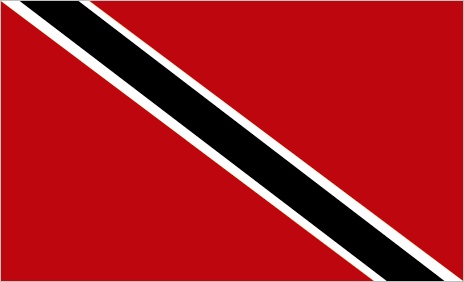Trinidad and Tobago, flag of
Flag History

national flag consisting of a red field (background) incorporating a diagonal black stripe with white fimbriations (narrow borders). The flag has a width-to-length ratio of 3 to 5.
As a British colony, Trinidad and Tobago displayed both the Union Jack (United Kingdom, flag of the) and the British Blue Ensign with a special badge. Specifically, Trinidad was granted a shield portraying a British ship arriving in harbour above a ribbon with the Latin motto “Miscerique probat populos et fœdera jungi,” translated as “He approves of the mingling of peoples and their being joined together by treaties.” Neither of these symbols was appropriate for the new nation, whose independence was achieved at midnight (12:00 AM) on August 31, 1962.
A committee had been established on the last day of May in 1962 to choose a new national flag for Trinidad and Tobago. Their selection, adopted on June 28 and approved by the College of Arms two weeks later, was officially hoisted for the first time on Independence Day and is still in use. It is a unique design with a diagonal stripe and contrasting colours. Earth, water, and fire as well as the past, present, and future of the country were associated with the black, white, and red of the design. In addition, black was seen as a symbol of dedication to unity, strength, and purpose. The white recalled the sea uniting the two principal islands of the nation, the equality of the people, and the purity of their aspirations. Red suggested the energy and warmth of the sun, the vitality of the people and nation, and the friendliness and courage of the inhabitants. No direct explanation was given for the diagonal stripe, but it was characteristic of the imaginative new designs that the Caribbean was to produce in national flags over the next two decades.
- Émile Combes
- Émile Coué
- Émile de Girardin
- Émile Derlin Zinsou
- Émile Deschamps
- Émile Durkheim
- Émile Fabre
- Émile Faguet
- Émile Gaboriau
- Émile Gallé
- Émile Gentil
- Émile Haug
- Émile Jaques-Dalcroze
- Heller, Hermann
- Heller, Joseph
- Heller, Robert
- Heller, Yom Ṭov Lipmann ben Nathan ha-Levi
- hellhound
- Hellman, Lillian
- Hello Kitty
- Hells Canyon
- Hellström, Gustaf
- H. Ellsworth, Jr. Vines
- H. Ellsworth Vines, Jr.
- Hellweg